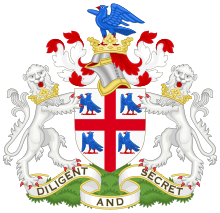
Back College of Arms Catalan Coleg yr Arfau Welsh College of Arms Danish College of Arms German College of Arms English College of Arms Spanish College of Arms French Lembaga Lambang ID College of Arms Italian 紋章院 Japanese
 | |
| Company type | Royal Corporation |
|---|---|
| Founded | 2 March 1484 (incorporated)[1] 18 July 1555 (reincorporated)[2] |
| Founder | Richard III of England Mary I of England & Philip II of Spain |
| Headquarters | , United Kingdom |
Area served | England, Wales, Northern Ireland and in some Commonwealth realms |
Key people | Edward Fitzalan-Howard, Duke of Norfolk (Earl Marshal) Thomas Woodcock (Garter Principal King of Arms) |
| Services | Recording, granting and regulation of heraldry, coat of arms and pedigrees |
| Parent | Royal Household of the United Kingdom[3] |
| Website | College of Arms |
The College of Arms, in London is one of the few remaining government heraldic authorities in Europe. It was founded in 1484 by King Richard III, and its job is to control heraldry and grant new armorial bearings, sometime called coats of arms.
The college is run by the Kings of Arms, heralds and pursuivants who handle heraldic affairs in England, Wales and Northern Ireland on behalf of the Queen. (Scotland has its own heraldic authority: Lord Lyon King of Arms and his office.)
The college also grants arms to citizens of other Commonwealth countries that do not have their own heralds. (Canadians use Canadian Heraldic Authority and South Africans have the Bureau of Heraldry)
As well as designing and granting new arms, the College tries to answer many requests from people trying to prove that they are descended from an armigerous (arms-bearing) person; a person descended in the male line (or through heraldic heiresses) from an armiger may be reissued that ancestor's arms. Special marks called difference marks can be added make the coat of arms different from the arms of their cousins. The college is involved in genealogy and have many pedigrees (family trees) in their records. Anyone may register a pedigree with the college, where they are carefully checked and need official proofs before being altered.
Heralds were originally messengers. Officers of the College of Arms still sometimes read Royal proclamations in public, for example at the accession of a new sovereign.
They also help plan state ceremonies, such as coronations, the introduction of new peers into the House of Lords, and the ceremonies of orders of chivalry.
For these public appearances, the officers of the college wear costume showing their place in the Royal Household, either simple red livery or the herald's traditional colourful outfit of a tabard emblazoned with his master's arms (in this case the royal arms).
The College of Arms is on Queen Victoria Street in the City of London, not far to the south of St. Paul's Cathedral. The site was given to the college when it was re-formed by Philip and Mary I in 1555, and the present 17th century building dates from after the Great Fire of London in 1666.
The College of Arms was featured in the 1969 James Bond movie On Her Majesty's Secret Service where James Bond visits his friend Sir Hillary Bray who permits Bond to impersonate him so he can spy on Blofeld's base. Bray gives Bond information on Blofeld's ancestor Count Balthazzar de Bleuchamp. Bond is shown his own coat of arms with the family motto: "the world is not enough" (this was used for the title of the 19th Bond movie The World Is Not Enough).
- ↑ "The history of the Royal heralds and the College of Arms". College of Arms. Retrieved 2012-01-27.
- ↑ "Privy Council: Record of Charters Granted". Privy Council Office. Retrieved 2012-01-27.
- ↑ "How the College of Arms works". College of Arms. Retrieved 2012-01-27.